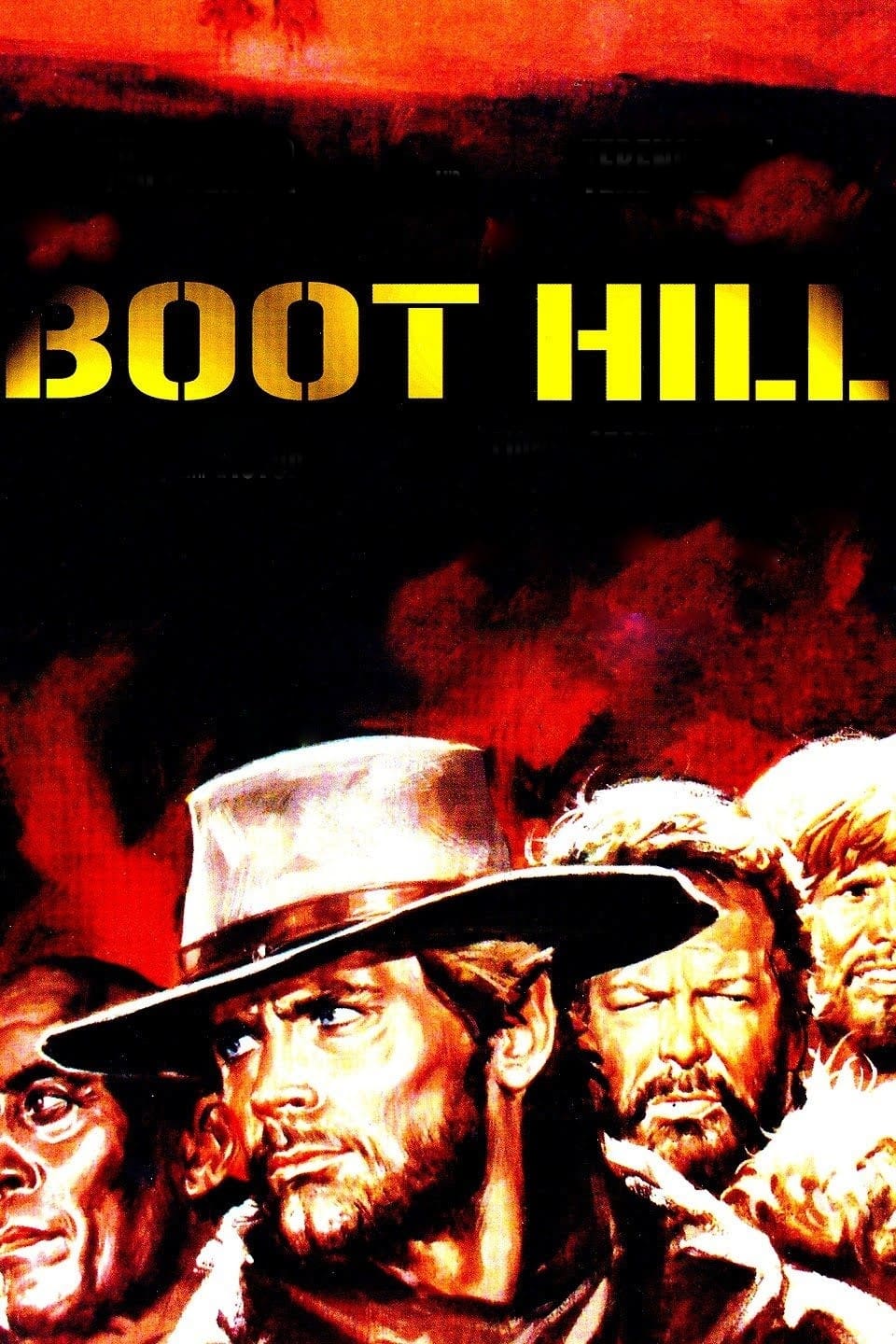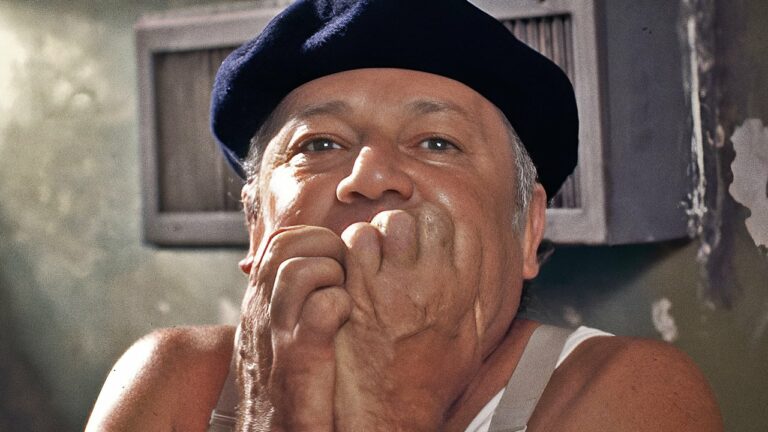
Boot Hill (La collina degli stivali), released in 1969, is a fascinating entry in the Spaghetti Western genre, blending traditional Western elements with an unexpected and whimsical circus backdrop. Directed by Giuseppe Colizzi, the film stars Terence Hill and Bud Spencer, one of cinema’s most beloved duos, alongside Woody Strode and Victor Buono. Boot Hill is the third and final installment of Colizzi’s trilogy featuring Hill and Spencer, following God Forgives… I Don’t! (1967) and Ace High (1968).
While Boot Hill retains the hallmarks of Spaghetti Westerns, such as stylized action, morally complex characters, and themes of revenge and justice, it stands out for its unconventional narrative structure, circus-inspired aesthetic, and moments of lighthearted humor. In this article, we’ll explore the film’s plot, themes, characters, stylistic choices, and its place in the legacy of Italian Westerns.
Plot Summary: A Tale of Revenge and Redemption
The story begins with Cat Stevens (Terence Hill), a wandering gunslinger, who is wounded in a shootout and left for dead. He is discovered by a traveling circus troupe, whose members nurse him back to health. Among the troupe is Thomas (Woody Strode), a former gunslinger turned circus performer, whose loyalty and courage play a pivotal role in the unfolding events.
As Cat recovers, he learns of an ongoing conflict in the nearby town, where a corrupt landowner named Finch (Victor Buono) is exploiting miners and terrorizing the local community. Finch, supported by a gang of ruthless enforcers, aims to seize control of the region by any means necessary.
Cat enlists the help of his old ally Hutch Bessy (Bud Spencer), a burly and good-natured gunslinger, as well as the circus troupe, to take a stand against Finch and his men. Together, they devise an elaborate plan that combines circus theatrics and cunning strategy to outwit Finch’s gang and rally the oppressed townsfolk to rise up for their freedom.
The film culminates in a thrilling and unconventional showdown that blends gunfights with acrobatics, emphasizing teamwork and resourcefulness over brute force.
Themes: Justice, Unity, and the Struggle Against Corruption
1. The Fight for Justice
At its core, Boot Hill is a story of justice versus tyranny. The film’s villains, led by Finch, symbolize unchecked greed and oppression, while the protagonists embody resistance and resilience. This struggle reflects a recurring theme in Spaghetti Westerns, where heroes confront corrupt power structures to restore balance and fairness.
2. Unity and Collaboration
A key theme in Boot Hill is the power of unity. Unlike many Westerns that focus on individual heroics, the film emphasizes collective action. Cat, Hutch, and the circus performers work together to confront Finch, highlighting the strength that comes from diverse individuals banding together for a common cause.
3. Redemption
The film explores redemption through its characters, particularly Thomas, whose past as a gunslinger contrasts with his present life as a circus performer. Thomas’s decision to join the fight against Finch reflects his journey toward reclaiming his sense of purpose and justice.
4. The Intersection of Reality and Performance
The integration of the circus into the Western setting creates an intriguing contrast between reality and performance. The circus acts serve as both entertainment and tools of resistance, blurring the line between spectacle and substance.
Characters: A Memorable Cast of Heroes and Villains
1. Cat Stevens (Terence Hill)
Terence Hill delivers a charismatic performance as Cat Stevens, a classic Spaghetti Western antihero. Cat’s wit, charm, and resourcefulness make him a compelling protagonist. Hill’s dynamic presence and chemistry with Bud Spencer are among the film’s highlights.
2. Hutch Bessy (Bud Spencer)
As Cat’s loyal companion, Hutch Bessy provides both comic relief and formidable strength. Spencer’s physicality and humor balance the film’s more serious moments, making Hutch a fan-favorite character.
3. Thomas (Woody Strode)
Woody Strode shines as Thomas, whose quiet dignity and physical prowess add depth to the narrative. A skilled performer and gunslinger, Thomas embodies the film’s theme of redemption and the blending of performance with resistance.
4. Finch (Victor Buono)
Victor Buono delivers a larger-than-life performance as the greedy and manipulative Finch. His portrayal of the film’s antagonist is equal parts menacing and theatrical, perfectly suiting the film’s tone.
5. The Circus Troupe
The circus performers bring a sense of whimsy and ingenuity to the story. Their acrobatics and showmanship add a unique layer to the action sequences, transforming the traditional Western formula into something fresh and unexpected.
Giuseppe Colizzi’s Direction: A Bold and Inventive Approach
1. Genre-Blending
Colizzi’s decision to incorporate the circus into a Western setting is a bold creative choice that sets Boot Hill apart from its contemporaries. The fusion of Western tropes with circus theatrics creates a visually and thematically distinctive film.
2. Action and Choreography
The action sequences in Boot Hill are a standout feature, combining traditional gunfights with acrobatics and stunts. Colizzi’s direction ensures that these scenes are both thrilling and inventive, showcasing the characters’ ingenuity.
3. Visual Style
Cinematographer Marcello Masciocchi captures the rugged beauty of the Western landscapes, contrasting them with the vibrant and colorful world of the circus. This juxtaposition enhances the film’s thematic exploration of reality versus performance.
4. Balancing Humor and Drama
Colizzi expertly balances the film’s humorous moments with its more serious themes. The interplay between Hill and Spencer provides plenty of laughs, while the story’s underlying message of justice keeps the narrative grounded.
Music: A Memorable and Atmospheric Score
The film’s score, composed by Carlo Rustichelli, is a crucial element of its identity. Rustichelli’s music combines traditional Western motifs with playful and whimsical melodies that reflect the circus theme. The score enhances the film’s unique tone, blending tension, humor, and adventure.
Reception and Legacy
Initial Reception
Upon its release, Boot Hill received mixed reviews, with some critics praising its inventive approach and others finding its genre-blending style unconventional. However, audiences appreciated the film’s humor, action, and the chemistry between Hill and Spencer.
Cultural Impact
Over time, Boot Hill has gained a cult following, particularly among fans of Spaghetti Westerns and the Hill-Spencer duo. Its innovative narrative and bold stylistic choices have solidified its place as a unique entry in the genre.
Part of a Trilogy
As the final installment in Colizzi’s trilogy, Boot Hill serves as a fitting conclusion to the adventures of Cat and Hutch. While it can be enjoyed as a standalone film, its connections to God Forgives… I Don’t! and Ace High provide additional depth for fans of the series.
Themes and Legacy in Spaghetti Westerns
Boot Hill represents a turning point in the Spaghetti Western genre, which began to evolve in the late 1960s. Its mix of traditional Western elements with unconventional storytelling and humor reflects the genre’s willingness to experiment and push boundaries.
The film’s emphasis on unity and redemption, as well as its critique of corruption and greed, resonates with the broader themes of Spaghetti Westerns. However, its circus-inspired aesthetic and lighthearted tone give it a distinct identity, making it a standout work in the genre’s history.
FAQs
1. What is Boot Hill about?
Boot Hill follows Cat Stevens, Hutch Bessy, and a circus troupe as they join forces to confront a corrupt landowner exploiting a mining town.
2. Who directed Boot Hill?
The film was directed by Giuseppe Colizzi, who also directed its predecessors, God Forgives… I Don’t! and Ace High.
3. Who stars in the film?
The main cast includes Terence Hill as Cat Stevens, Bud Spencer as Hutch Bessy, Woody Strode as Thomas, and Victor Buono as Finch.
4. How does Boot Hill differ from other Spaghetti Westerns?
The film incorporates circus elements, blending Western action with acrobatics and theatricality, making it a unique entry in the genre.
5. Is Boot Hill part of a series?
Yes, it is the third film in a trilogy that also includes God Forgives… I Don’t! and Ace High.
Conclusion: A Bold and Inventive Western
Boot Hill is a testament to the creativity and versatility of the Spaghetti Western genre. With its unconventional narrative, memorable characters, and inventive action sequences, the film continues to captivate audiences and inspire appreciation for its bold storytelling.
As the final chapter in Giuseppe Colizzi’s trilogy, Boot Hill offers a satisfying blend of humor, drama, and spectacle, ensuring its place as a beloved classic of Italian cinema.





